Method for Detecting Underwater Microbubbles Using Dual-Mode Fusion of Laser Polarization
Abstract
:1. Introduction
2. Dual-Mode Fusion Detection Mechanism
- Ideal bubble state simulation. This paper establishes a dynamic time-varying simulation model of underwater microbubbles based on the vector Monte Carlo method, which can be used to simulate the polarization characteristics of bubbles of different sizes and numbers according to different water quality parameters fed back from the detector, and outputs the corresponding data as the historical optimal values to provide the corresponding parameters for the subsequent algorithms.
- Image fusion and feature extraction. This paper proposes an image polarization-weighted fusion method based on polarization fluctuation changes, using polarized image and non-polarized image coefficient weighting, image enhancement of the target of the bubble to be detected, and segmentation of adherent bubbles by the fast radial symmetric transform method (FRS), then combined with ellipse fitting to complete the contour estimation and data expansion, and the relevant feature parameters are output for the subsequent bubble feature recognition statistics.
- Dual-mode fusion discrimination. This paper proposes a dual-mode fusion bubble feature recognition method based on the inter-correlation between image scattering and bubbles, through the feedback of the fluctuation of the gray value of the image in the two cases of the existence or non-existence of bubbles, and the use of laser polarization and the image of the data complementary to the image from the perspective of statistical probability of the image grayscale and bubble polarization features for the fusion of confidence and the establishment of the bubble size, number, and other discriminative features in an a posteriori distribution probability model. In the experimental test phase, according to the target confidence adaptive fusion dual-mode detection results, the impurities and bubble characteristics are accurately distinguished, and the grayscale fluctuation value (GF) is used to correlate bubble size, number, and other characteristics, so as to realize the target identification and feature extraction of bubbles under complex water quality.
2.1. Ideal Bubble State Simulation
- (a)
- The Stokes vector of the incident photon in the direction is converted to the Stokes vector of the scattering plane as the reference plane. The rotation matrix of the Stokes vector from the meridional plane to the scattering plane is as follows:where represents the angle of clockwise rotation of to along . By substituting Equation (2) into Equation (3), we can calculate the Stokes vector defined by the incident light on the scattering plane before scattering occurs:where represents the Stokes vector in the incident direction with respect to the meridional plane . represents the Stokes vector of relative to the scattering plane .
- (b)
- On the scattering plane , the Stokes vector of photons in the direction after scattering is calculated using the bubble Mueller matrix . The Mueller matrix can describe the polarization characteristics of the scattering process. Since the Stokes vector is relative to a scattering plane, it is necessary to transform the Stokes vector into the scattering plane , and then use the incident Stokes vector to multiply the scattering matrix to solve the Stokes vector after photon scattering, namely:where represents the Stokes vector of the scattering photon in the direction with respect to the scattering plane .
- (c)
- The Stokes vector of the photon in the direction of is transformed from the scattering plane to the meridian plane of . The Stokes vector of the scattered photon relative to the new meridional is as follows:
2.2. Image Fusion and Feature Extraction
2.3. Dual-Mode Fusion Discrimination
3. Experimental Design and Result Analysis
3.1. Experimental Components
3.2. Result Analysis
4. Conclusions
Author Contributions
Funding
Institutional Review Board Statement
Informed Consent Statement
Data Availability Statement
Acknowledgments
Conflicts of Interest
References
- Wang, D.; Josset, D.; Savelyev, I.; Anguelova, M.; Cayula, S.; Abelev, A. An Experimental Studyon Measuring Breaking-WaveBubbles with LiDAR. Remote Sens. 2022, 14, 1680. [Google Scholar]
- Li, W.; Yang, K.; Xia, M.; Rao, J.; Zhang, W. Influence of characteristics of micro-bubble clouds on backscatter lidar signal. Opt. Express 2009, 17, 17772–17783. [Google Scholar] [PubMed]
- Olsen, J.E.; Skjetne, P. Modelling of underwater bubble plumes and gas dissolution with an Eulerian-Lagrangian CFD model. Appl. Ocean. Res. 2016, 59, 193–200. [Google Scholar]
- Abbaszadeh, M.; Alishahi, M.M.; Emdad, H. Experimental investigations on the bubbly wake of a transom stern model using optical laser beam scattering characteristics. Appl. Ocean. Res. 2020, 104, 102380. [Google Scholar]
- Josset, D.; Cayula, S.; Concannon, B.; Sova, S.; Weidemann, A. On the bubble-bubbleless ocean continuum and its meaning for the LiDAR equation: LiDAR measurement of underwater bubble properties during storm conditions. Opt. Express 2024, 32, 20881–20903. [Google Scholar]
- Song, Q.; Sun, X.B.; Liu, X.; Ti, R.F.; Huang, H.L.; Wang, H. Exploring target imaging in underwater bubble group environment based on polarization information. Acta Phys. Sin. 2021, 70, 210–225. [Google Scholar]
- Ma, T.; Hessenkemper, H.; Lucas, D.; Bragg, A.D. Effects of surfactants on bubble-induced turbulence. Fluid Mech. 2023, 970, A13. [Google Scholar]
- Tan, W.; Liu, X.; Wu, D.; Luo, B.; Zhao, M.; Guo, Y.; Long, J.; Zhang, Y. Measurement of Bubble Group Characteristics of Gas-Liquid Two-Phase Flow by Laser Cross Section Imaging. Acta Opt. Sin. 2022, 42, 1510001. [Google Scholar]
- Qian, S.Y.; Chen, J.J.J. Effect of liquid fraction and bubble size distribution on the polarised light scattering characteristics of Casein foam. Chem. Eng. Sci. 2015, 122, 250–269. [Google Scholar]
- Ma, T.; Hessenkemper, H.; Lucas, D.; Bragg, A.D. Fate of bubble clusters rising in a quiescent liquid. Fluid Mech. 2023, 973, A15. [Google Scholar]
- Zhao, Y.; He, W.; Ren, H.; Li, Y.; Fu, Y. Polarization descattering imaging through turbid water without priorknowledge. Opt. Lasers Eng. 2022, 148, 106777. [Google Scholar]
- Shukla, P.; Sumathi, R.; Gupta, S.; Pradhan, A. Influence of size parameter and refractive index of the scatterer on polarization-gated optical imaging through turbid media. J. Opt. Soc. Am. A 2007, 24, 1704–1713. [Google Scholar]
- Li, H.; Zhu, J.; Deng, J.; Guo, F.; Sun, J.; Zhang, Y.; Hou, X. Influence mechanism of the particle size on underwater active polarization imaging of reflective targets. Opt. Express 2023, 31, 7212–7225. [Google Scholar] [PubMed]
- Hu, H.; Zhao, L.; Li, X.; Wang, H.; Liu, T. Underwater image recovery under the nonuniform optical field based on polarimetric imaging. IEEE Photonics J. 2018, 10, 1–9. [Google Scholar]
- Zhang, Y.; Cheng, Q.; Zhang, Y.; Han, F. Image-restoration algorithm based on an underwater polarization imaging visualization model. J. Opt. Soc. Am. A 2022, 39, 855–865. [Google Scholar] [CrossRef]
- Ramella-Roman, J.; Prahl, S.; Jacques, S. Three Monte Carlo programs of polarized light transport into scattering media: Part I. Opt. Express 2005, 13, 4420–4438. [Google Scholar]
- Miller, S.; Ding, Y.; Jiang, L.; Tu, X.; Pau, S. Observation of elliptically polarized light from total internal reflection in bubbles. Sci. Rep. 2020, 10, 8725. [Google Scholar]
- Song, Q.; Liu, X.; Huang, H.; Ti, R.; Sun, X. Polarization Reconstruction Algorithm of Target Based on the Analysis of Noise in Complex Underwater Environment. Front. Phys. 2022, 10, 813634. [Google Scholar]
- Liang, S.; Wang, J.; Zong, S.; Wu, R.; Ma, Z.; Wang, X.; Wang, L. Laser detection method of ship wake bubbles based on multiple scattering intensity and polarization characteristics. Acta Phys. Sin. 2013, 62, 060704. [Google Scholar]
- Wang, J.; Wan, M.; Cao, X.; Zhang, X.; Gu, G.; Chen, Q. Active non-uniform illumination-based underwater polarization imaging method for objects with complex polarization properties. Opt. Express 2022, 30, 46926–46943. [Google Scholar]
- Fan, L.; Sun, G.; Qiu, J.; Ma, Q.; Hess, P.; Li, A. Effect of seawater salinity on pore-size distribution on a poly(styrene)-based HP20 resin and its adsorption of diarrhetic shellfish toxins. J. Chromatogr. A 2015, 1373, 1–8. [Google Scholar] [CrossRef] [PubMed]
- Treibitz, T.; Schechner, Y. Active polarization descattering. IEEE Trans. Pattern Anal. Mach. Intell. 2009, 31, 385–399. [Google Scholar] [CrossRef] [PubMed]
- Wei, Y.; Han, P.; Liu, F.; Shao, X. Enhancement of underwater vision by fully exploiting the polarization information from the Stokes vector. Opt. Express 2021, 29, 22275–22287. [Google Scholar] [CrossRef] [PubMed]
- Andres, A.; Hernández, M. To have value, comparisons of high-throughput phenotyping methods need statistical tests of bias and variance. Front. Plant. Sci. 2023, 14, 1325221. [Google Scholar]
- Zong, S.G.; Chen, B.; Zhang, X.; Duan, Z.; Yang, S.; Li, X. Laser forward and backward scattering characteristics and experimental study of bubbles in ship wake. Appl. Opt. 2024, 63, 1795. [Google Scholar] [CrossRef]
- Zong, S.; Zhang, X.; Duan, Z.; Yang, S.; Chen, B. Research on Laser Dual-Mode Fusion Detection Method of ShipWake Bubbles. Appl. Sci. 2024, 14, 3695. [Google Scholar] [CrossRef]
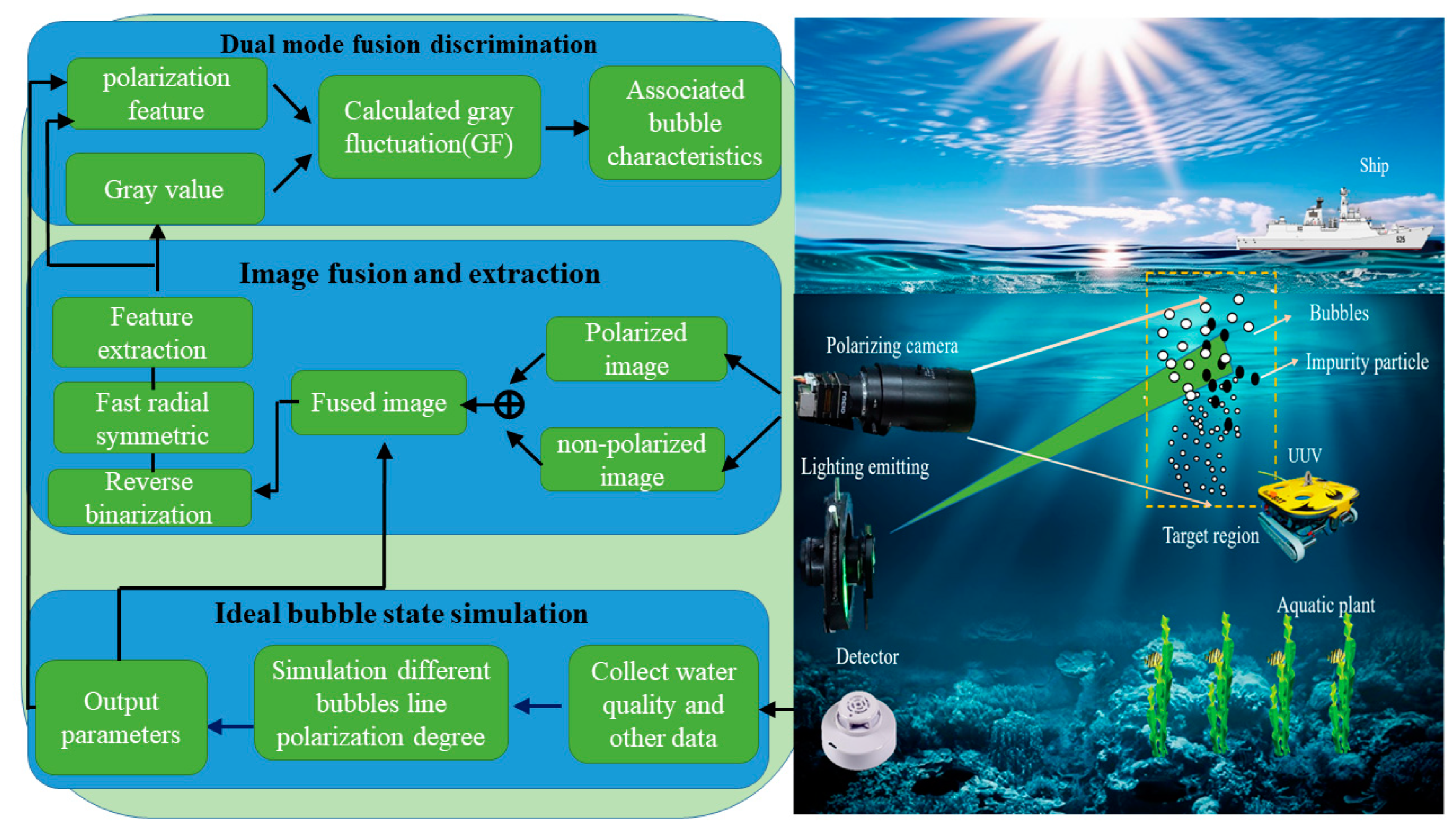
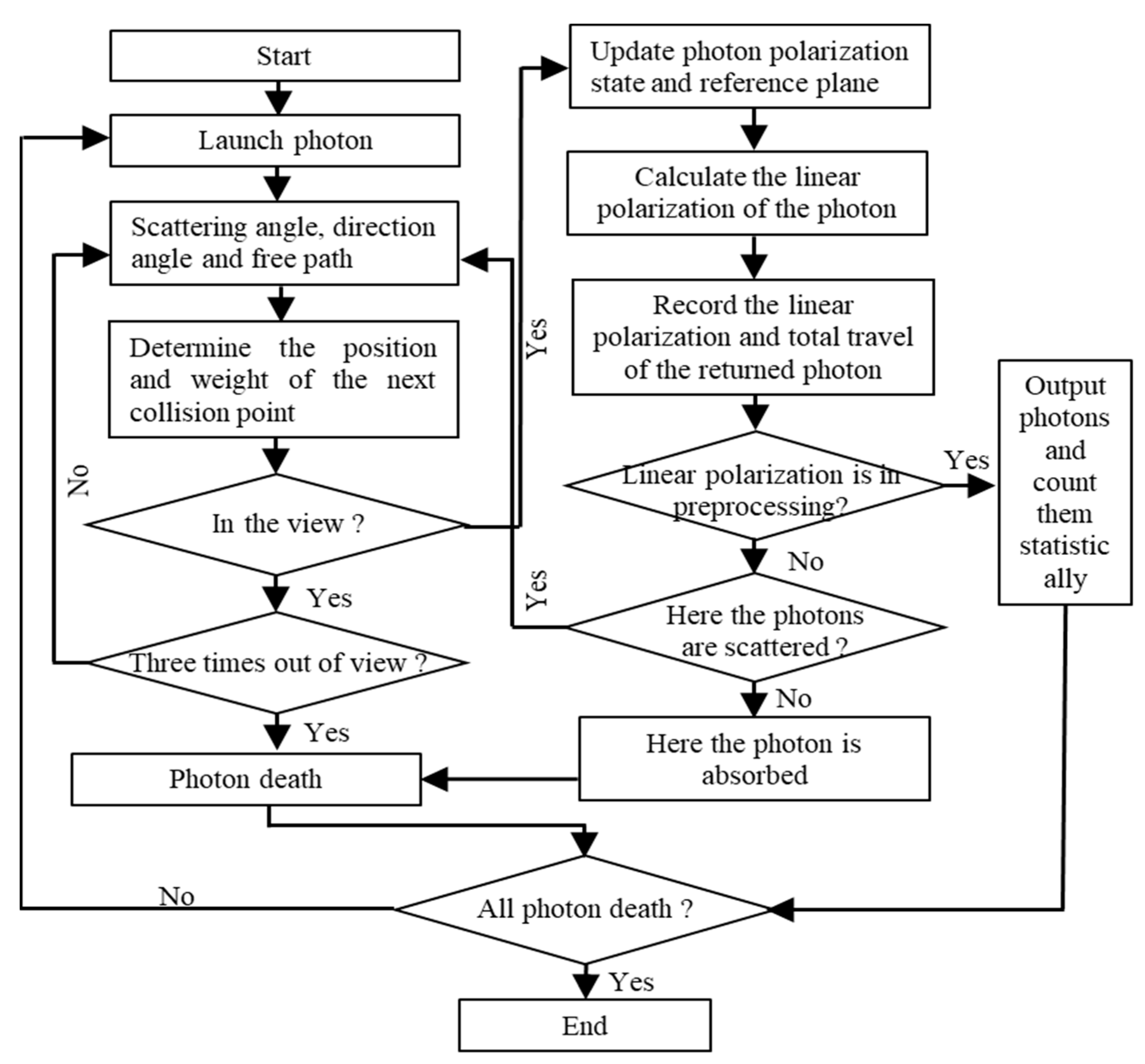
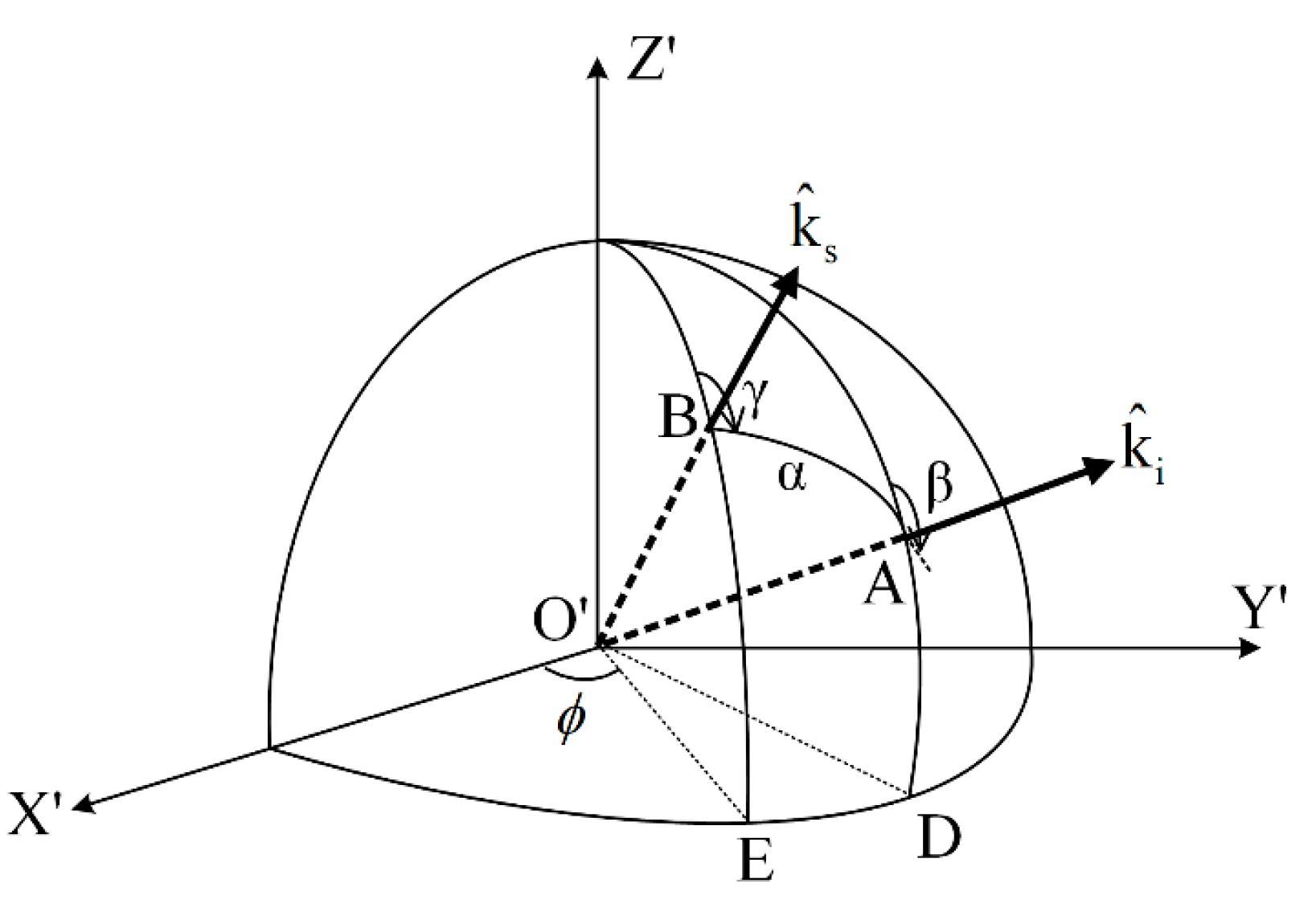

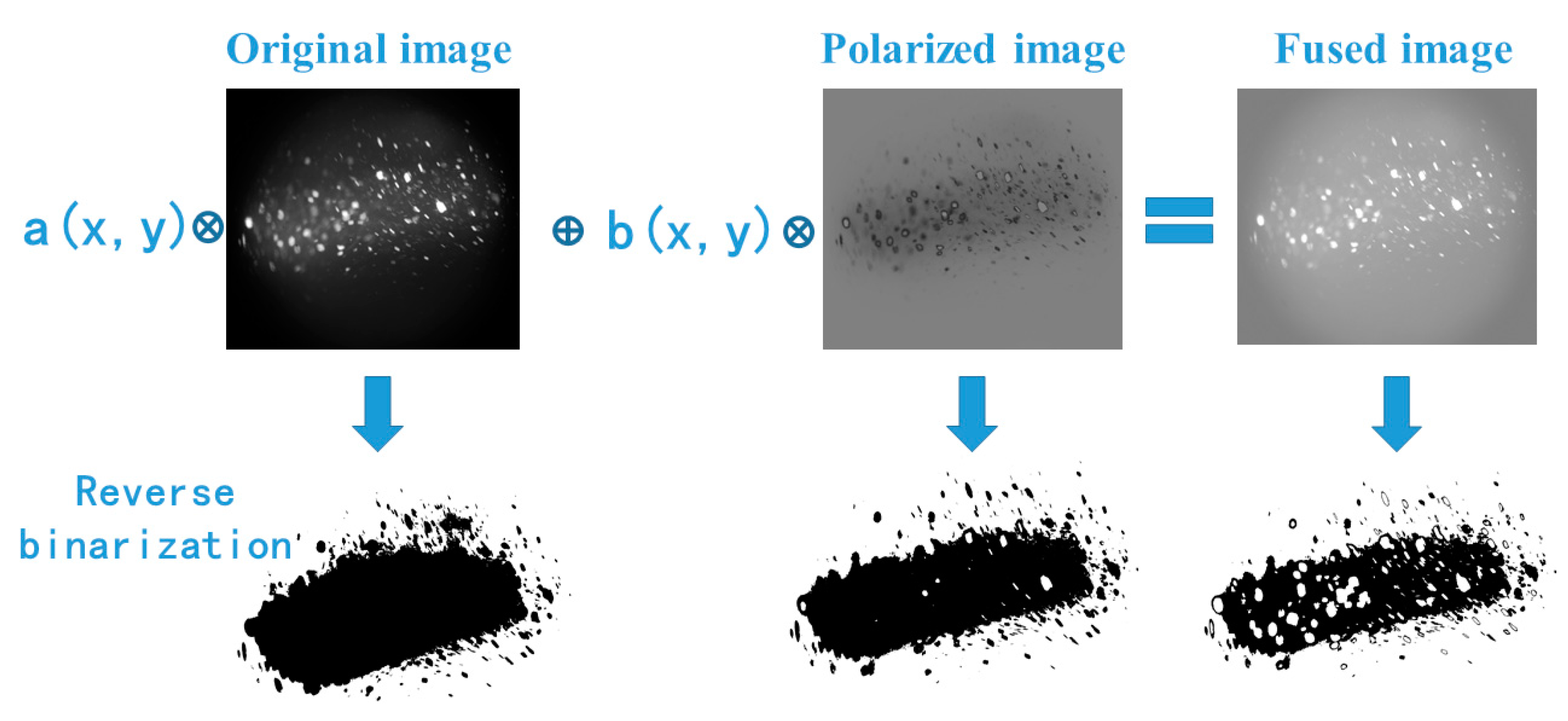
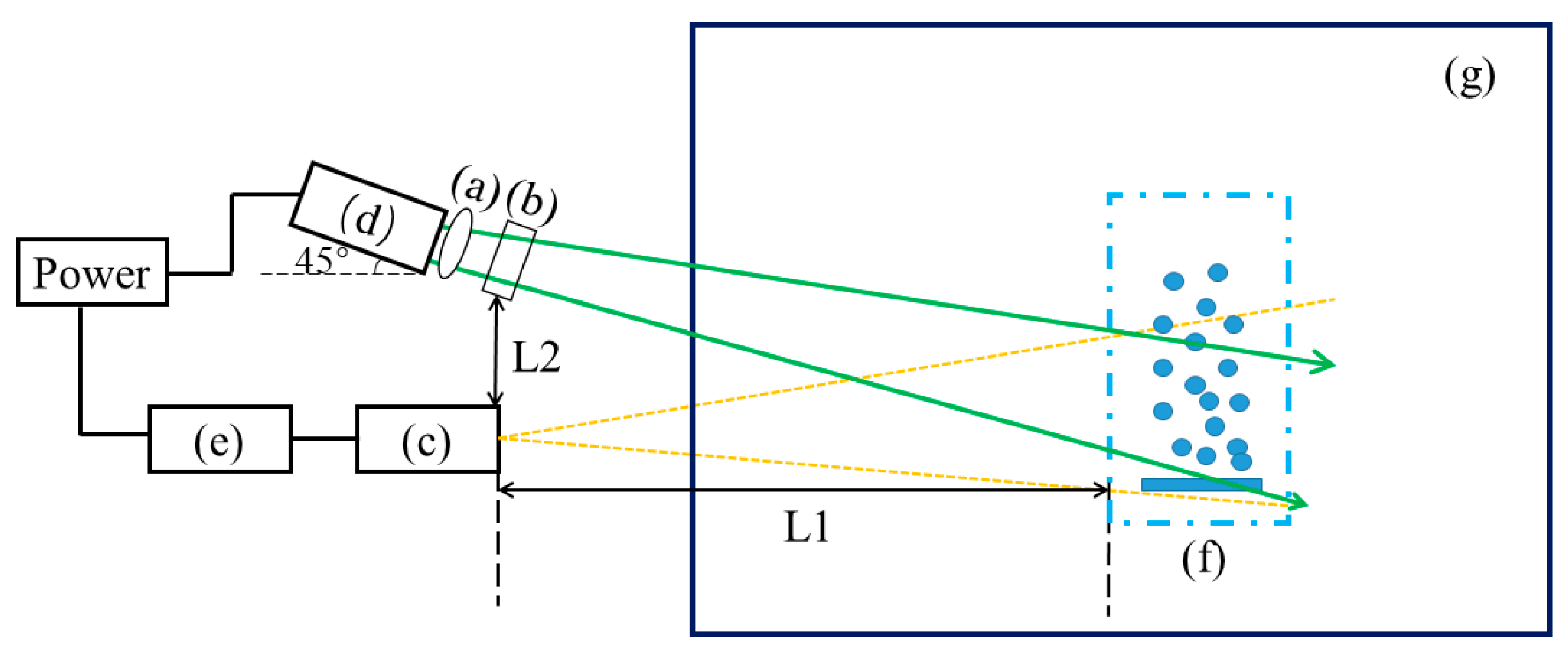

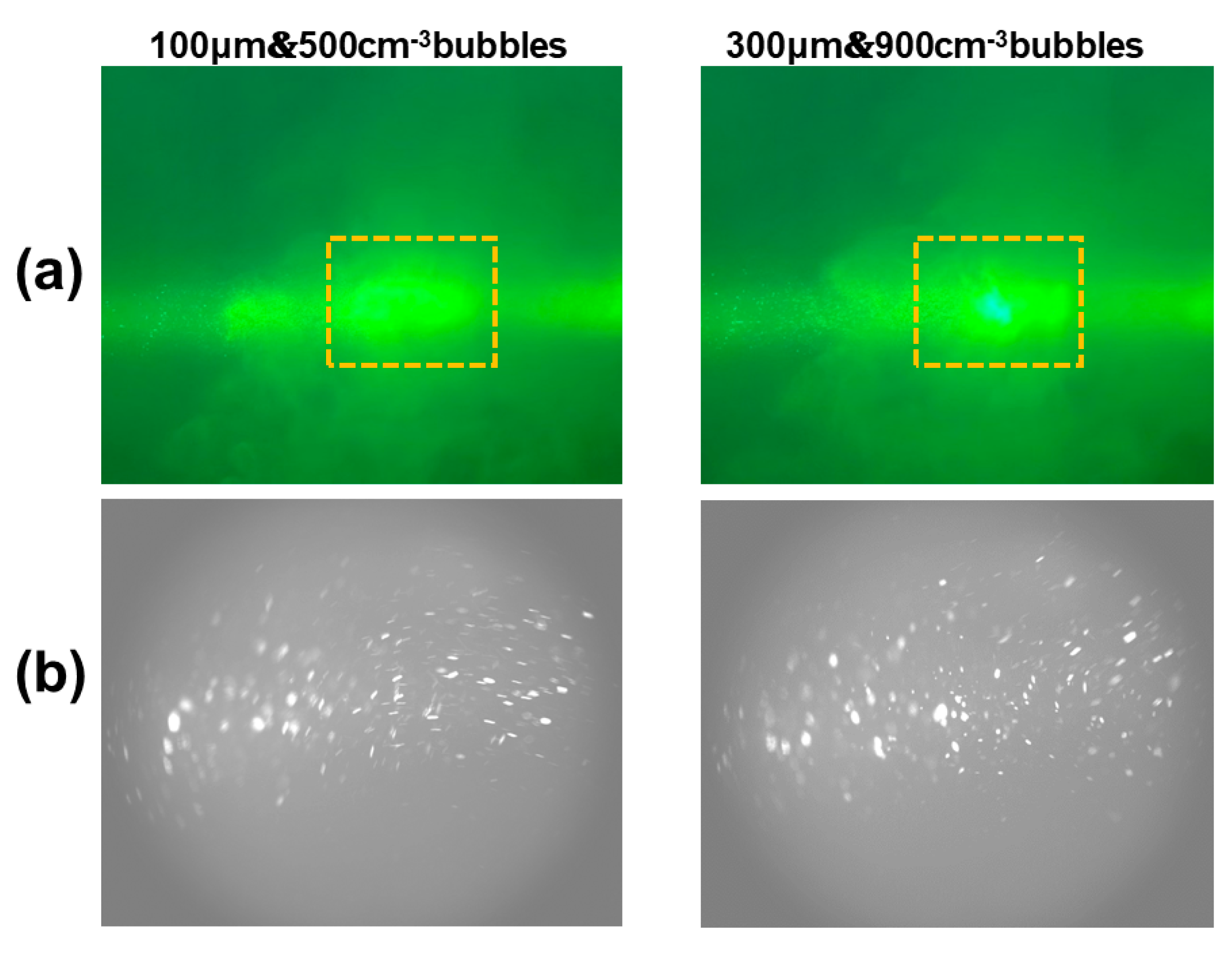
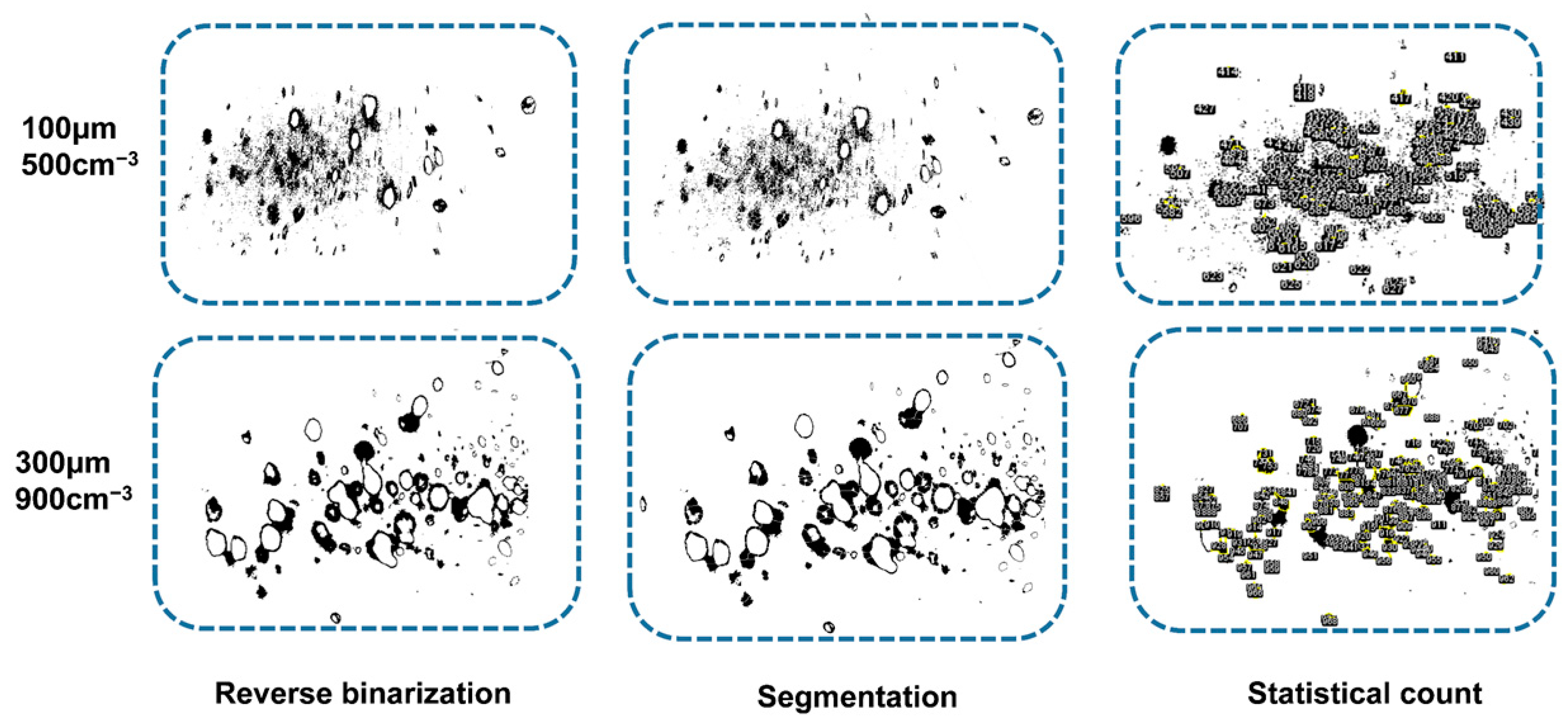
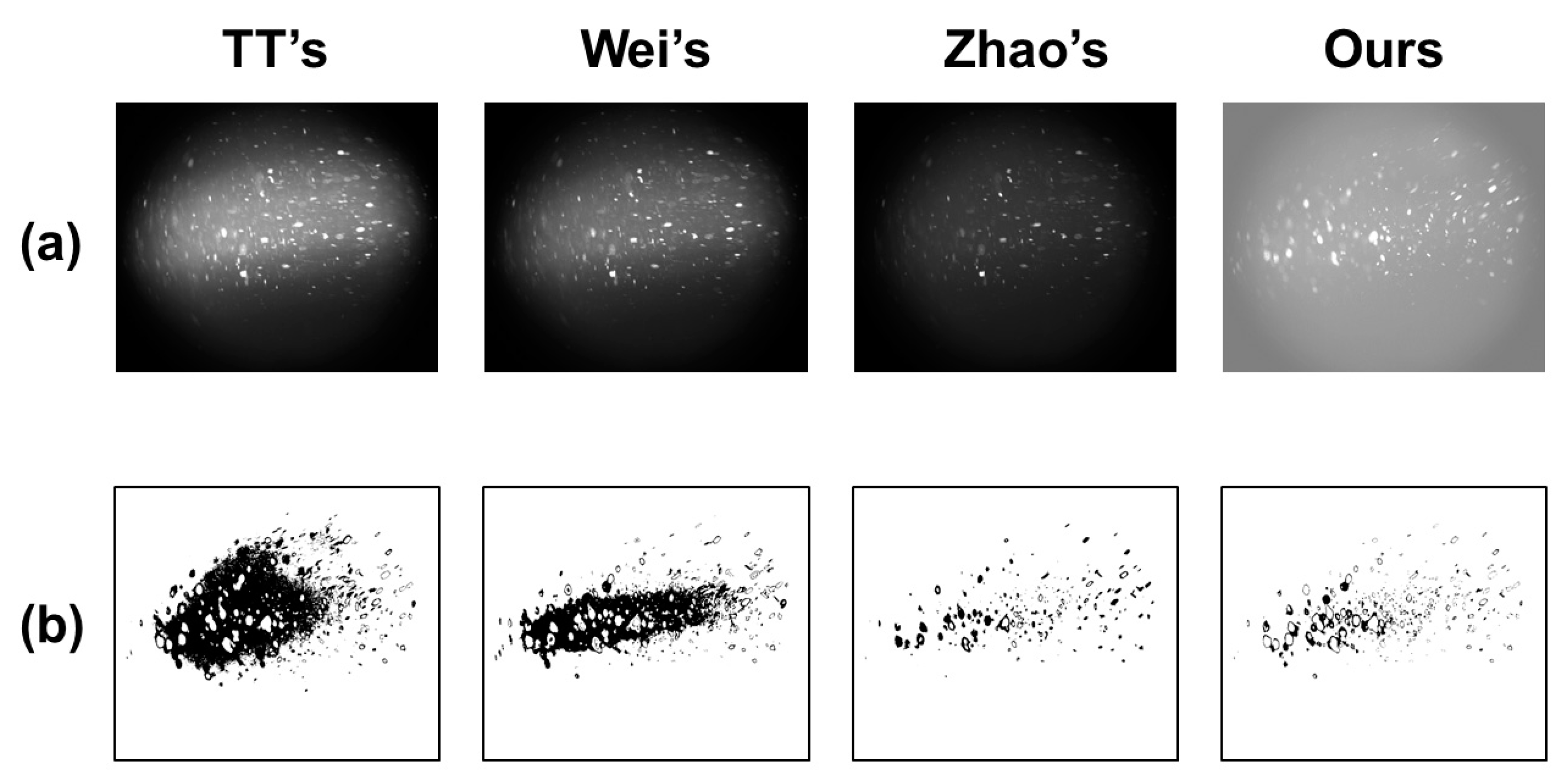

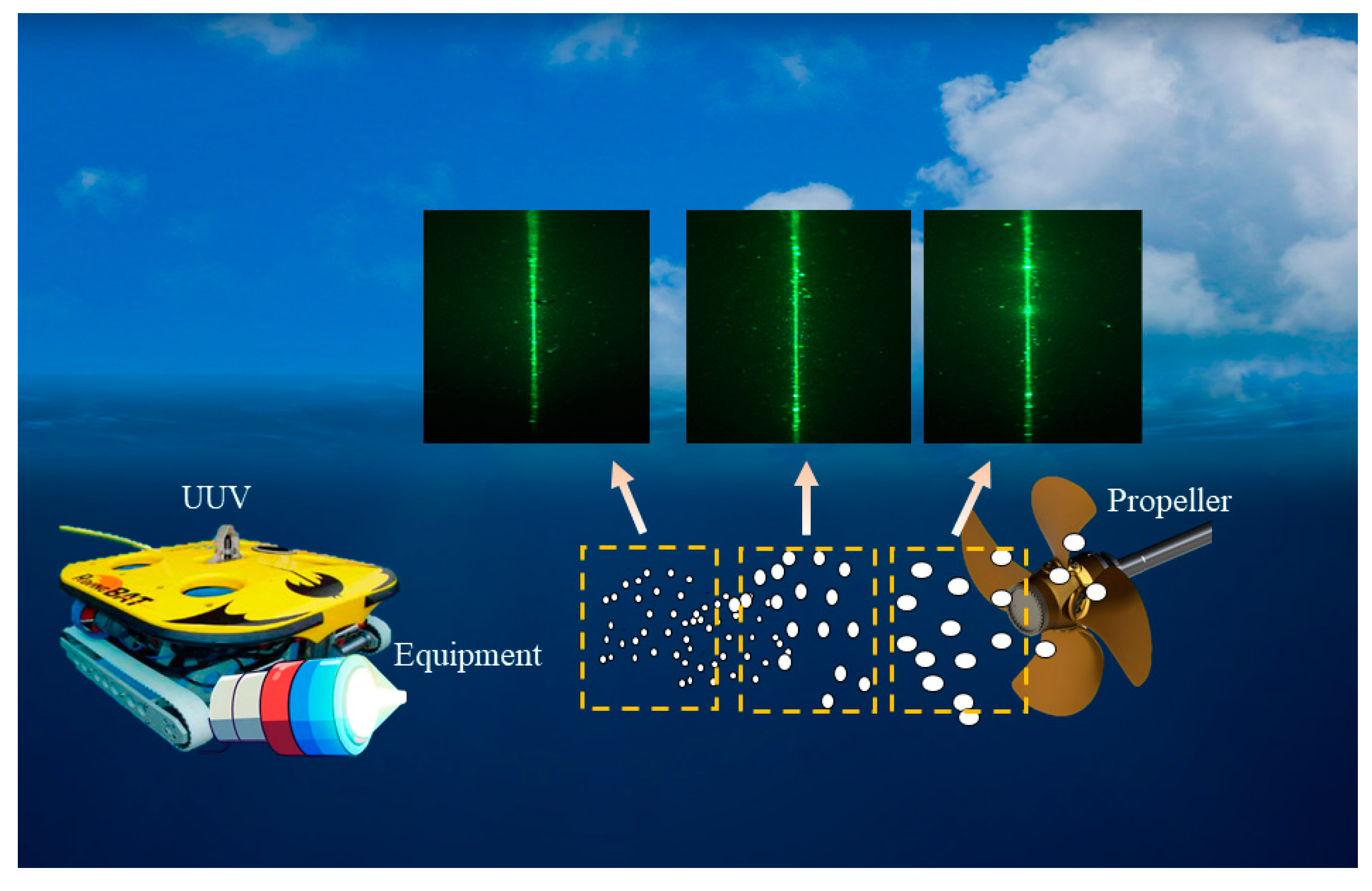

| Method | TT’s [22] | Wei’s [23] | Zhao’s [11] | Our |
|---|---|---|---|---|
| Detection rate | 75.6% | 84.7% | 81.2% | 95.3% |
| 0.364 | 0.205 | 0.064 | 0.051 |
| R2 | 0.9352 | RMSE | 0.0503 |
|---|---|---|---|
| a | 0.4694 | b | 0.020 |
| c | 0.1843 | ω | 0.679 |
Disclaimer/Publisher’s Note: The statements, opinions and data contained in all publications are solely those of the individual author(s) and contributor(s) and not of MDPI and/or the editor(s). MDPI and/or the editor(s) disclaim responsibility for any injury to people or property resulting from any ideas, methods, instructions or products referred to in the content. |
© 2024 by the authors. Licensee MDPI, Basel, Switzerland. This article is an open access article distributed under the terms and conditions of the Creative Commons Attribution (CC BY) license (https://creativecommons.org/licenses/by/4.0/).
Share and Cite
Zong, S.; Yang, S.; Liang, S. Method for Detecting Underwater Microbubbles Using Dual-Mode Fusion of Laser Polarization. Appl. Sci. 2024, 14, 8465. https://doi.org/10.3390/app14188465
Zong S, Yang S, Liang S. Method for Detecting Underwater Microbubbles Using Dual-Mode Fusion of Laser Polarization. Applied Sciences. 2024; 14(18):8465. https://doi.org/10.3390/app14188465
Chicago/Turabian StyleZong, Siguang, Shaopeng Yang, and Shanyong Liang. 2024. "Method for Detecting Underwater Microbubbles Using Dual-Mode Fusion of Laser Polarization" Applied Sciences 14, no. 18: 8465. https://doi.org/10.3390/app14188465






